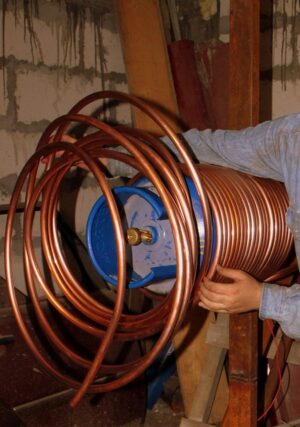The traditional water heater tank, once a bulky and cumbersome component in plumbing installations, is undergoing a transformative shift towards lightweight design. This innovation promises to revolutionize not only transportation and installation processes but also enhance safety and efficiency. By employing advanced materials and streamlined assembly techniques, modern water heater tanks are lighter, more maneuverable, and easier to install.
This article explores the multifaceted benefits of this game-changing technology, from reducing physical strain during transport to achieving energy efficiency gains, ultimately shaping the future of residential and commercial water heating systems.
- Lightweight Design: Revolutionizing Water Heater Tank Transport
- – Exploring the challenges of traditional water heater tanks in transportation
- – Benefits of lightweight materials: reduced weight and improved maneuverability
Lightweight Design: Revolutionizing Water Heater Tank Transport

The lightweight design of modern water heater tanks is a game-changer in the industry, offering significant advantages when it comes to transportation and installation. Unlike traditional water heaters, which can be bulky and cumbersome, these innovative models are engineered to reduce weight without compromising performance or tank capacity. This revolutionizes the way water heater tanks are moved and installed, especially in residential settings.
By adopting a lighter structure, manufacturers have made these tanks easier to handle and transport, allowing for more efficient distribution and reduced labor costs during installation. Whether it’s gas tank heaters, electric tank heaters, or storage water heaters, the lightweight design caters to various preferences while ensuring convenience and flexibility. This advancement is particularly beneficial for tight spaces where traditional hot water storage systems might struggle, providing a practical solution for modern homes and businesses alike.
– Exploring the challenges of traditional water heater tanks in transportation

Transporting and installing traditional water heater tanks can be a complex and cumbersome task, primarily due to their size and weight. These bulky water heater tanks, often referred to as hot water storage systems, are designed for residential use but present significant challenges during movement. Their large tank capacity requires specialized equipment and skilled labor, making installation a costly and time-consuming endeavor. This is particularly true in areas where access is limited, such as tight urban spaces or remote residential locations.
Furthermore, traditional gas tank heaters and electric tank heaters are not always easily maneuverable, requiring careful planning to ensure safe transportation without damaging surrounding structures or causing injury. In contrast, lightweight water heater tanks offer a revolutionary solution by prioritizing ease of movement without compromising performance, thereby streamlining both transportation and installation processes for residential water tanks.
– Benefits of lightweight materials: reduced weight and improved maneuverability

The use of lightweight materials in modern water heater tanks offers significant advantages, particularly when it comes to transportation and installation. One of the key benefits is the reduction in overall weight, which makes handling and moving these tanks much easier. This is especially beneficial during the installation process, as technicians can navigate tight spaces with greater ease, ensuring a more efficient setup. Improved maneuverability also means that residential water tanks, whether gas tank heaters or electric tank heaters, can be installed in locations previously inaccessible due to their weight and size.
Additionally, lighter materials contribute to a simpler and faster installation process. Unlike traditional water heaters, which often require substantial effort and equipment to install due to their heavy hot water storage systems, lightweight tanks can be swiftly positioned and secured, saving time and labor costs. This efficiency is further amplified when considering the tank capacity, as larger capacities can now be handled with less strain, opening up new possibilities for tailored hot water storage solutions.
The lightweight design of modern water heater tanks is a significant advancement, offering easier transportation and installation compared to their traditional counterparts. By utilizing innovative materials, manufacturers have achieved remarkable weight reduction, enhancing overall maneuverability. This not only simplifies the process for professionals but also empowers homeowners to install these tanks with greater convenience. The resulting efficiency in handling water heaters contributes to faster project completion times and reduced labor costs, making it a game-changer in both residential and commercial applications.






